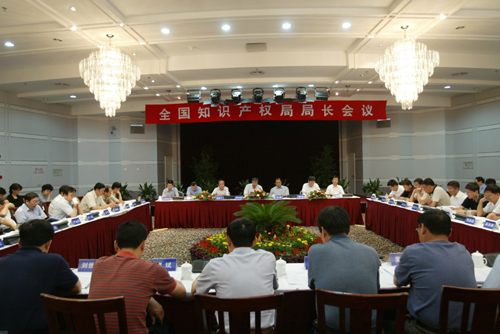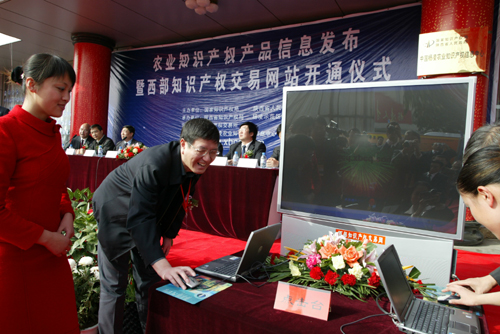Chapter VI Patent Administration

September 12, SIPO held the National Meeting of the Heads of IP Offices.
In 2005, patent administration across the nation was further strengthened and achieved notable results. .
1. The Work in the Model Zones for Implementing the IP System
The work in the Model Zones for implementing the IP System across the nation was further regulated and enhanced. According to the Directions on the Work in the Model Zone for Implementing the IP System and the ideas of promoting through models and of developing through demonstrations, the Office propelled the IP work of cities, high-tech parks, companies and organizations at the two levels, models and demonstrations. First, based on the directions, overall objective, principles and specific requirements for model works, the Office set up the evaluation index system for model cities, parks and companies and organizations. Second, the Office intensified field studies, summarized and analyzed the results, experiences and problems and expanded the scale. In 2005, 12 new model cities and 6 parks were added, amounting to 59 cities, 11 parks and 80 companies and organizations nationwide as of now. Third, the Office organized meetings of model organizations, training courses for companies and organizations and dialogue between patent examiners and companies. 167 good patent examiners were sent to the second group of 80 model companies and organizations and would finish 140 patent situation reports. Fourth, the Office organized the check of the second group of model companies and organizations and the selection of the third group of model companies and organizations. Nine cities including Guangzhou and Wuhan were approved to be the model cities. Fifth, following the working plan and arrangements of the model and demonstration, various tasks were implemented, including the construction of IP organizations, policy system and custom-made database, information utilization, patent strategy study, patent protection, promotion of the commercialization of patented technologies and R & D of independent IP core technologies.
In 2005, the work in the Model Zones for implementing the IP System had made great progress. IP innovation, administration, exploitation and protection capacities of the cities, parks, companies and organizations were extensively strengthened. The work had also effectively influenced the work of local IP administrations.
2. National Patent Commercialization Project
The trail National Patent Commercialization Project Bases were expanded to 10. According to the principles of focusing on the construction of patent commercialization system for different industries and fields and soft and hard supporting platform for the patent commercialization while taking account the local reality, the Office continued promoting the National Patent Commercialization Project. A number of products, industries and companies supported by independent IPRs emerged which facilitated the adjustment and upgrading of the Chinese economic and technological structure and fostered some new economic growing spots for the country.
In October, at the National Workshop on the Patent Exploitation and Commercialization, Deputy Commissioner Xing Shengcai delivered a speech titled, Recognize the Situation, Identify the Tasks and Promote Patent Exploitation and Commercialization.
3. Ministry-related IP Administration
First, in cooperation with the Ministry of Science and Technology, the Office concluded the patent strategy reports on the dairy industry, water-preserving agriculture and semi-conductor illumination. Second, The Office participated in the inter-agency coordination mechanism, for instance, National Inter-Ministry Task Force on the Protection of Biological Species Resources, Coordination Group on China's Implementation of the Convention on Biodiversity, State Council's National Office of Rectification and Standardization of Market Economic Order, National Inter-Ministry Task Force on Verification and Certification. Third, the Office Supported IP training of other ministries and industries, for example, Ministry of Water Conservancy. Fourth, the Office and the Ministry of Information Industry jointly held briefings on patent situation of the information technology. Fifth, subject to the requirements for the formulation of the National Intellectual Property Strategy, the Office intensified connection with other ministries and participated in their relevant policy-making. Sixth, the Office coordinated with other ministries to tackle patent problems met in relevant industries and trade.
4. Construction of Specialized IP Information Centers
In response to the urgent need for patent information by pillar industries in different areas, the Office jointly with local administrations continued to promote the construction of IP information centers of specific industrial themes. First, the Office formulated a regulation governing the delivery of patent information resources to the local administrations and its relevant procedures. Second, the Office approved some new specialized IP information centers in some areas, for example, Xiangtan machinery and electronics information center. There are currently 19 such centers approved while 13 of them are in operation. Third, as requested, the Office enhanced its support to improve the construction of the current specialized information centers, including expanding updated data and scope of service, improving service functions, providing data processing service and increasing service quality.
5. Trade Facilitation through IP Project
In an attempt to make good use of IP in facilitating trade through science and technology, the Office initiated the trade facilitation through IP project. First, it organized the joint meeting on trade facilitation through IP that was also a project study workshop. Second, it studied and formulated the plan for the trade facilitation project. Third, it organized study on patent licensing trade during international technology trade and its relevant policies. Fourth, it organized the international forum on trade facilitation through science and technology and intellectual property protection. Fifth, it approved four national trade facilitation through IP bases including a border town, Huoerguosi. Six, it held IP training courses directed towards outbound companies.
6. Revitalize Northeast Traditional Industrial Bases
The Office continued the project in revitalizing the northeast traditional industrial bases. IP work in the three northeastern provinces were facilitated by intensifying patent information service, conducting patent strategy studies of pillar industries, assisting large state-owned companies in IP work, strengthening intermediary services and executing IP plans taking account local revitalization symposia.
7. National Patent Market Administration
In 2005, the Office handled 90 registrations, modifications and cancellations of mortgages on patent rights, a 91.5% increase over the previous year. Among all the cases, there were 66 registrations of mortgages on patent rights, 78.4% increase over the previous year with the mortgage value of 5,039,2000 yuan, 4.03 times over the previous year, and the debit value of around 1,263,976,300 yuan, 2.84 times over the previous year. One modification registration was handled. 23 revocations of patent mortgage was handled, 2.86 times over 2004. A total of 82 domestic companies recorded the patent licensing contracts, involving 223 domestic patents or applications. A total of 3 foreign companies recorded the patent licensing contracts, involving 313 domestic patents or applications and 7,882 foreign patents or applications. The Office directly handled 24 registrations of advertisement certificate issuance.
The Office organized a workshop on recordation of patent licensing contracts and a national workshop on recordation of patent licensing contracts, compiled and published a pamphlet titled the Instructions on Patent Licensing Contracts and organized the statistics collection of patent licensing contracts of 2005.

Deputy Commissioner He Hua launched the web site for posting of agricultural
IP information and IPR transactions by clicking the site at Yangling Agriculture
High-tech Trade Fair.
Strengthened management of state -level patent exhibitions. The Office drafted a plan on the promotion of patent markets, and a plan on the transaction platform of national patented technology markets, participated in the organization of 2010 Shanghai EXPO, held exhibitions with local governments and State Council agencies, for example, Dalian Patent Trade Fair, Yangling Agriculture High-tech Trade Fair, Beijing Science and Technology EXPO, Shenzhen High-tech Trade Fair, China Hefei High-tech Projects Fair and Shangdong Qufu China Patented High-tech Projects EXPO. All these activities promoted the commercialization and industrialization of patented technologies.
The Office initiated a survey on the patent commercialization and relevant independent IPR products and industries after 20 years of the implementation of the Patent Law.
8. Field Study of the Protection of Traditional Medicine in Southeast Guizhou
Deployed by the Office's traditional medicine IP protection leading group, organized a project implementation plan.
A joint task force, including members from the Office, Guizhou IP Administration and Southeast Guizhou Autonomous State, was set up to collect information, cases by survey and study to have a thorough understanding of the IP protection of traditional medicine in Southeast Guizhou. The task force completed its report and made proposals. The project was evaluated and accepted.
9. Construction of Work Mechanism
In 2005, IP coordination systems were established around the nation. Shenzhen formed a IP administration governing patent and copyright affairs. A SIPO patent receiving branch was set up in Shenzhen, which made the total number of receiving branches 21. Regional city IP work mechanism was further enhanced. Several regional city and county also established their IP administrations.
10. Patent Awards
In 2005, the Office successfully organized the selection of Ninth Chinese Patent Award. The selection received 278 recommendations from some State Council ministries, agencies, local IP administrations, Fellows of Chinese Academy of Sciences and Chinese Academy of Engineering. The number and technological quality exceeded the previous selections. After strict selection, 15 Chinese Patent Gold Medals were determined. Among them, there were 12 invention patents, 2 utility model patents and 1 design patent. There were also 119 Chinese Patent Awards.
2013-07-17 Print
Print